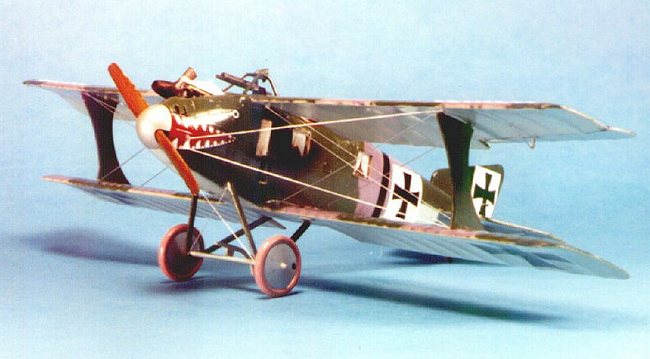
|
KIT: |
Eduard 1/48 Roland C.II 'Walfisch' |
|
KIT # |
|
|
PRICE: |
$29.95 |
|
DECALS: |
See review |
|
REVIEW & |
|
|
NOTES: |
|

|
HISTORY |
The L.F.G. Roland C.II "Walfisch" was likely the best-looking two seater to be flown by any air force during the Great War. The airplane represented a revolutionary moment in the history of aircraft design; by filling the wing gap with the fuselage, eliminating the cabane struts thereby, the designers produced a low-drag, highly streamlined biplane with a significant speed advantage over its contemporaries. The crew were presented with a magnificent in-flight view, though downward vision on landing was so poor that nearly every Roland pilot suffered at least one landing accident. The look of the airplane was such that it fully deserved its name, "Walfisch," which is German for "Whale."
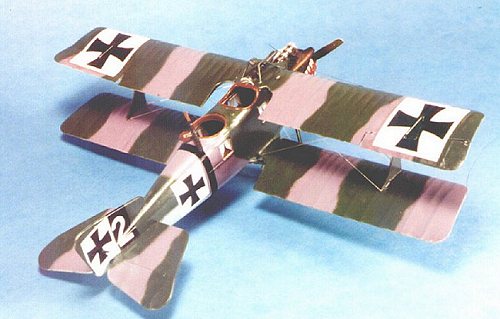 At the
outbreak of the war, LFG Roland was given several small production contracts by
Idflieg, the headquarters of the German flying service, to build the Albatros
B.II and C.II biplanes under license. The Roland engineers were quickly
convinced they could do better, and set out to reduce drag and increase
performance without resorting to higher-horsepower engines. The robust fuselage
they developed was created from two layers of veneer strips, rapped diagonally
around a mold, glued and reinforced with fabric. The two built-up fuselage
halves - which were far lighter in weight than any other two-seat design - were
then attached to a lightweight inner support frame. The resulting semi-monocoque
fuselage was exceptionally strong and resilient.
At the
outbreak of the war, LFG Roland was given several small production contracts by
Idflieg, the headquarters of the German flying service, to build the Albatros
B.II and C.II biplanes under license. The Roland engineers were quickly
convinced they could do better, and set out to reduce drag and increase
performance without resorting to higher-horsepower engines. The robust fuselage
they developed was created from two layers of veneer strips, rapped diagonally
around a mold, glued and reinforced with fabric. The two built-up fuselage
halves - which were far lighter in weight than any other two-seat design - were
then attached to a lightweight inner support frame. The resulting semi-monocoque
fuselage was exceptionally strong and resilient.
The Roland C.II prototype first flew October 24/25, 1915. In speed trials, it demonstrated a speed advantage of 30 kph over contemporary 2-seaters, a performance close to that of Allied single-seater scouts. The airplane went into production December 23, 1915. The first Roland C.II production machines arrived on the Western Front in March 1916, and the type remained in first-line operational service until June, 1917. The aircraft was also built under license by Linke-Hofman Werke AG, where it was known as the Roland C.II(Li).
The C.II was a formidable opponent to the Nieuport 11 and Sopwith Pup by which it was first opposed, and often acted as an escort fighter for slower German 2-seaters, as well as artillery spotting, bombing raids and long range reconnaissance missions where its high speed gave it an advantage. Unfortunately, the high sides of the fuselage restricted view below, which created a blind spot that could be taken advantage of. Captain Albert Ball often used the upward firing ability of the wing-mounted Lewis Gun on his Nieuport 17 to attack Rolands, coming out of a dive to initiate his attack from below. Even so, the Roland was a formidable opponent, and several times Ball found himself fleeing back to Allied lines, pursued by Rolands.
Throughout its service in 1916, the Roland C.II gained a measure of fame out of all proportion to the relatively limited numbers that served with German units on the Western Front.
|
THE KIT |
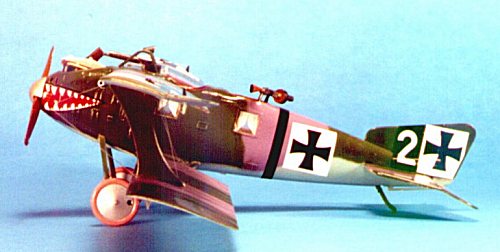 Outside
of an now-elderly (bit still quite good) 1/72 scale kit of the Roland C.II from
Airfix, the only other kits available of this interesting airplane have been a
1/48 vacuform from Sierra Scale Models which is still available, a very
primitive kit in 1/48 from Pegasus in the early 1990s, and a limited-run
injection kit from Blue Max that came out in 1999, which is in this reviewer's
opinion not one of the better products from that company. Thus, getting an
injection-molded kit from Eduard that is the WW1 equivalent of a Tamiya or
Hasegawa kit in terms of production standards is very nice indeed. The kit
arrived on three trees of light tan plastic, crisply molded with wing detail
that looked a bit heavy, but came out looking excellent under a coat of paint,
with decals for an aggressive-looking "Walfisch" with a mouth full of
teeth from 1916, and an airplane from the Geschwader Schule at Paderborn in
1917. Eduard have moved far beyond the "limited run" appellation of
their original releases, and are now a fully state-of-the-art injection molded
plastic model manufacturer.
Outside
of an now-elderly (bit still quite good) 1/72 scale kit of the Roland C.II from
Airfix, the only other kits available of this interesting airplane have been a
1/48 vacuform from Sierra Scale Models which is still available, a very
primitive kit in 1/48 from Pegasus in the early 1990s, and a limited-run
injection kit from Blue Max that came out in 1999, which is in this reviewer's
opinion not one of the better products from that company. Thus, getting an
injection-molded kit from Eduard that is the WW1 equivalent of a Tamiya or
Hasegawa kit in terms of production standards is very nice indeed. The kit
arrived on three trees of light tan plastic, crisply molded with wing detail
that looked a bit heavy, but came out looking excellent under a coat of paint,
with decals for an aggressive-looking "Walfisch" with a mouth full of
teeth from 1916, and an airplane from the Geschwader Schule at Paderborn in
1917. Eduard have moved far beyond the "limited run" appellation of
their original releases, and are now a fully state-of-the-art injection molded
plastic model manufacturer.
|
CONSTRUCTION |
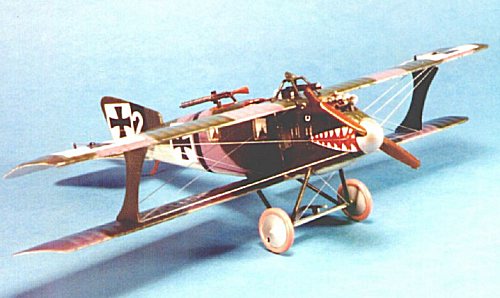 Outside
of cutting the flight control surfaces and re-positioning them, this model was
built directly from the box following the instruction sheet as to painting and
assembly, with no problems. My only deviation was that, when it came to the
internal cockpit equipment that was in natural varnished wood, I used some light
wood decal, then painted with Gunze-Sanyo "Clear Yellow" as varnish. I
also used seat belts from the Eduard First World War German photo-etch set. A
review of the photos in the Roland C.II Datafile shows a number of small dials
and switches that will likely be added onto the photoetch fret that will
accompany the "profipack" version of this model; however, like the
Pfalz D.IIIa, these items are only "gilding the lily," and most
modelers will have no problem getting along without them.
Outside
of cutting the flight control surfaces and re-positioning them, this model was
built directly from the box following the instruction sheet as to painting and
assembly, with no problems. My only deviation was that, when it came to the
internal cockpit equipment that was in natural varnished wood, I used some light
wood decal, then painted with Gunze-Sanyo "Clear Yellow" as varnish. I
also used seat belts from the Eduard First World War German photo-etch set. A
review of the photos in the Roland C.II Datafile shows a number of small dials
and switches that will likely be added onto the photoetch fret that will
accompany the "profipack" version of this model; however, like the
Pfalz D.IIIa, these items are only "gilding the lily," and most
modelers will have no problem getting along without them.
With the fuselage assembled, and all seams filled with Mr. Surfacer 500, I attached the tail surfaces and lower wings to the fuselage and was then ready to paint.
|
PAINT & DECALS |
Painting:
I decided to do the combat airplane, a photograph of which appears in the Datafile. (I have only one question for the Archangel Rimmel with this: the photograph shows the airplane from the right side, and apparently there are no other photos of this airplane available, yet the Archangel did indeed paint a profile of the airplane from the left side - my question being, "how can you be sure?")
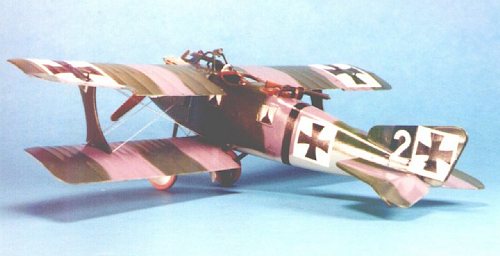 I
painted the model overall Gunze-Sanyo H-65 "Hellblau," WW2 RLM65 blue,
on the basis of the suspicion among many WW1 modelers now that the basic German
WW2 colors were carry-overs from WW1. This certainly matches the "turquoise
blue" called for. I camouflaged the upper surfaces Mauve and Dark Green,
using a private mixture of Gunze-Sanyo Violet, Rot23 Red, and Sky Grey for the
Mauve, and Euro One "Dark Green". When finished I shot two coats of
Future and set things aside to dry.
I
painted the model overall Gunze-Sanyo H-65 "Hellblau," WW2 RLM65 blue,
on the basis of the suspicion among many WW1 modelers now that the basic German
WW2 colors were carry-overs from WW1. This certainly matches the "turquoise
blue" called for. I camouflaged the upper surfaces Mauve and Dark Green,
using a private mixture of Gunze-Sanyo Violet, Rot23 Red, and Sky Grey for the
Mauve, and Euro One "Dark Green". When finished I shot two coats of
Future and set things aside to dry.
Decals:
The kit decals went down with no problem and snuggled right into position under two applications of Micro-Sol. When this was dry, I washed the model, then applied another light coat of Future to seal everything.
Final Assembly:
I attached the top wings, "I" struts, landing gear, prop, turnover bar, and fore and aft machine guns, and all was finished easily.
Rigging:
The Roland C.II has only interplane wires, and these are easily attached. This airplane is the essence of simplicity for those would-be WW1 modelers who are "rigging challenged."
|
CONCLUSIONS |
This "slammer" just might be the easiest WW1 airplane model kit Eduard has produced yet. It is certainly a -perfect "First WW1 Project" for any modeler, and will give the biplane-fearful the self-confidence to proceed with kits of the Nieuport or the Roland D.III series, which would be logical next steps. It's a good-looking airplane, sure to get comment wherever it's seen.
Thanks to Eduard Model Company for the review copy.
If you would like your product reviewed fairly and quickly by a site that has over 900 visits a day, please contact me or see other details in the Note to Contributors.